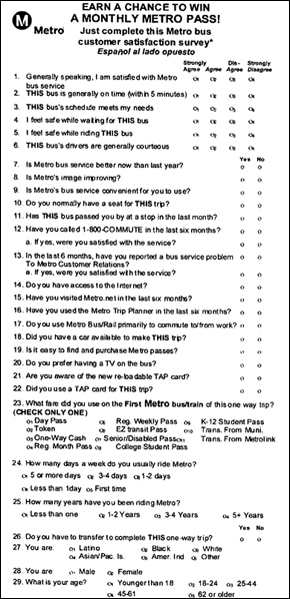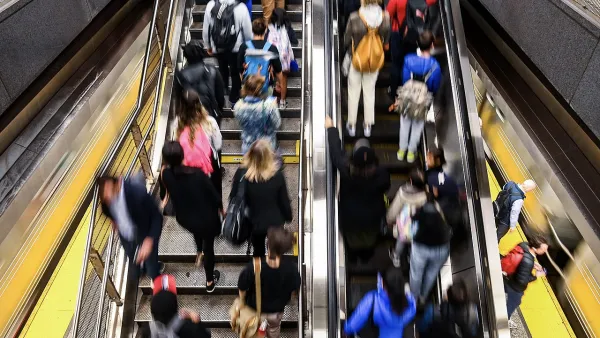On the bus this morning I was handed a survey asking me to detail my satisfaction with the Los Angeles County Metropolitan Transportation Authority's public transit system. As a daily bus commuter, I was more than happy to spend my two cents, but I'm a bit skeptical that those two cents will really do anything.
On the bus this morning I was handed a survey asking me to detail my satisfaction with the Los Angeles County Metropolitan Transportation Authority's public transit system. As a daily bus commuter, I was more than happy to spend my two cents, but I'm a bit skeptical that those two cents will really do anything.
The survey included 29 questions, mostly of the "Yes or No" variety. They asked about things like the relative safety of the bus, its timeliness, its quality, the courtesy of the driver, and other general questions about my personal preferences for and opinions of the system and its service.
There wasn't anything especially groundbreaking about this survey, and though it could have gone into much greater depth, it covered the basic topic areas you'd expect in a service evaluation. For a very simple survey, I think it could reveal some overall trends in the system, most significantly along the lines of timeliness and safety.

One area not covered was ease of use. I'm pretty used to the system, but I think it is incredibly unwelcoming to new or unexperienced riders. In this blog post at Next American City, I get into detail about shortcomings in the system's signage, mapping, and accessibility to new users.
To its credit, the survey did include one question I was very happy to see: "Did you have a car available to make THIS trip?" I said yes, and I'm really curious to see how many other people did, too.
Most of the people the surveyor asked to take the survey obviously speak English as a second or third language. Many of the people I witnessed on my this two-mile leg of my commute, however, were comfortable enough with the language to politely decline to fill out the survey.
About half of the 30-40 riders on my trip filled out the survey, which was printed in both English and Spanish.
The survey collector (who was nicely clad in a bright orange reflector vest) said his independent firm would be surveying riders on every one of the MTA's bus and rail lines. With almost 200 lines throughout the county, they've got plenty of work to do.
I think it's a good idea for transit agencies to try to get this kind of information directly from the people they serve. It should be interesting to see how riders respond to this satisfaction survey, and even more interesting to see what the MTA actually does as a result. But with thousands of paper-and-pencil surveys, and a notoriously politicized and slow-moving planning process, it may be a while before the satisfaction of riders has any justification to increase.

Planetizen Federal Action Tracker
A weekly monitor of how Trump’s orders and actions are impacting planners and planning in America.

Chicago’s Ghost Rails
Just beneath the surface of the modern city lie the remnants of its expansive early 20th-century streetcar system.

Amtrak Cutting Jobs, Funding to High-Speed Rail
The agency plans to cut 10 percent of its workforce and has confirmed it will not fund new high-speed rail projects.

Ohio Forces Data Centers to Prepay for Power
Utilities are calling on states to hold data center operators responsible for new energy demands to prevent leaving consumers on the hook for their bills.

MARTA CEO Steps Down Amid Citizenship Concerns
MARTA’s board announced Thursday that its chief, who is from Canada, is resigning due to questions about his immigration status.

Silicon Valley ‘Bike Superhighway’ Awarded $14M State Grant
A Caltrans grant brings the 10-mile Central Bikeway project connecting Santa Clara and East San Jose closer to fruition.
Urban Design for Planners 1: Software Tools
This six-course series explores essential urban design concepts using open source software and equips planners with the tools they need to participate fully in the urban design process.
Planning for Universal Design
Learn the tools for implementing Universal Design in planning regulations.
Caltrans
City of Fort Worth
Mpact (founded as Rail~Volution)
City of Camden Redevelopment Agency
City of Astoria
City of Portland
City of Laramie





























